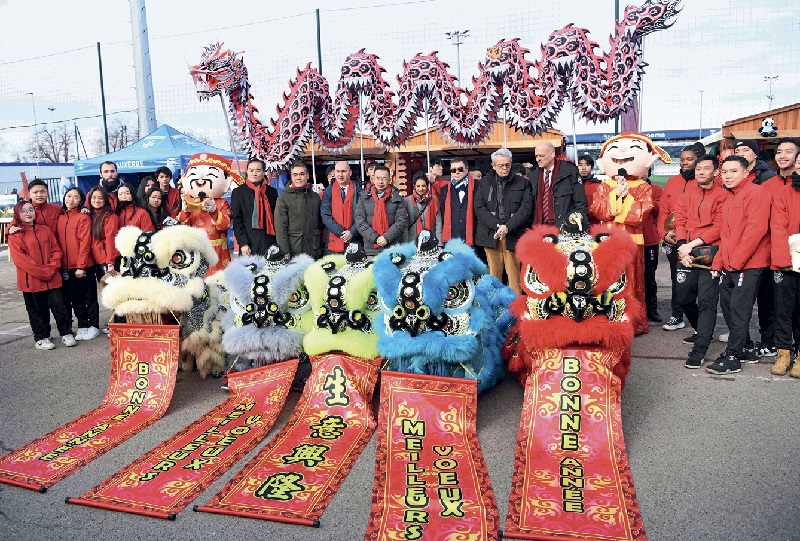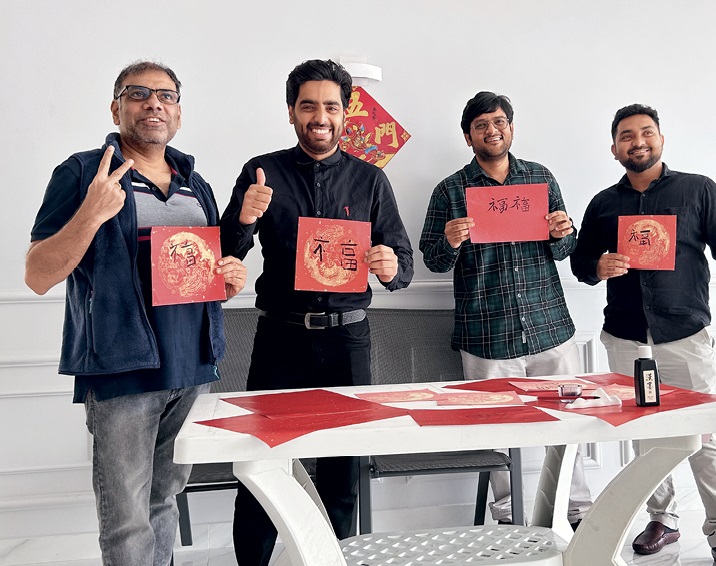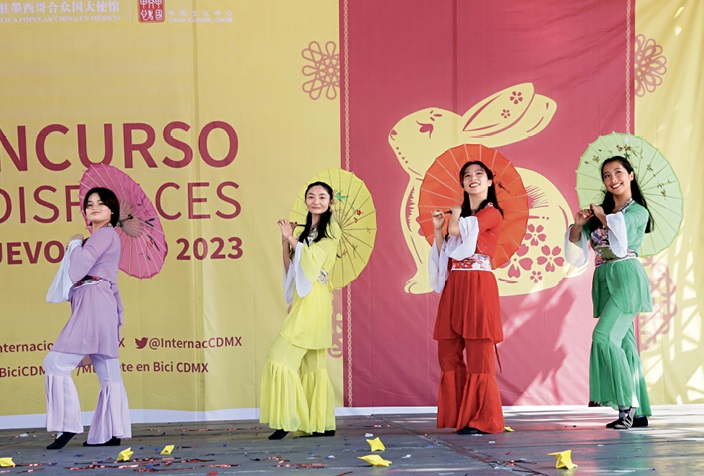Experiencing the Charm of Chinese Culture
China ushered in the Year of the Rabbit in the lunar calendar in January 2023. According to traditional Chinese culture, the rabbit represents agility, purity, and tranquility. The auspicious rabbit augurs well for Chinese people’s increasingly peaceful and prosperous life.
Many countries around the world also celebrate the Chinese New Year in various ways. Landmark buildings around the globe light up in “Chinese red,” traditional Chinese folk performances like the dragon and lion dance staged in central districts and boulevards, and traditional Chinese cuisine allows locals to experience the rich tastes of China. Celebrations have been held in many places worldwide, not only to send New Year wishes to the Chinese people, but also to allow people around the world to immerse themselves in the joyful and peaceful Chinese Spring Festival culture.

Chinese Ambassador to France Lu Shaye (fourth left in the center group of officials on the first row) and performers of lion dance take a photo outside the Abbe Deschamps Stadium of Auxerre Club before a French Ligue 1 match between Auxerre and Montpellier as part of the Day of China activities celebrating the Chinese Lunar New Year in Auxerre, France, on January 29, 2023.
Warmth for the World
The Spring Festival is the grandest and liveliest traditional festival in China.
During the first Spring Festival after China eased its COVID-19 response, an increasing number of Chinese people chose to travel abroad, injecting growth momentum for the tourism industry in many countries which are struggling to recover from the protracted COVID-19 pandemic.
Popular ski resort Jungfrau in Switzerland decked out its cable car terminal with Chinese lanterns and decorations featuring the Year of the Rabbit. The airport in Indonesia’s Bali greeted Chinese tourists with traditional Chinese lion dances on the Chinese New Year. A flight carrying Chinese tourists got a water salute as it landed at the Velana International Airport in the Maldives. The Thai deputy prime minister greeted Chinese tourists at the airport. The Philippine Tourism Secretary expressed gratitude to China for resuming tourism exchanges with the Philippines, and said that the Philippines is open and ready to welcome friends from China.
In the early morning of February 6, Dubai International Airport in the United Arab Emirates also welcomed the first group from China. The flight operated by Dubai-based Emirates airline took some 60 tourists from China’s Guangzhou to the Arab capital city. Local staff at the arrival gate held the flags of the two countries to convey the warm welcome of Arab friends to Chinese tourists. The seven-star hotel Burj Al Arab Jumeirah which the tour group chose also held a warm welcome ceremony for the tourists.
Just before the Spring Festival, Egypt welcomed its first Chinese tourist group after the outbreak of the pandemic, and locals held a warm and grand welcome ceremony. Feng Jian from Sichuan, a member of the tour group, was traveling abroad for the first time in three years. He said that the reason why he chose Egypt is because Egypt, like China, is an ancient civilization and so he wanted to experience its culture firsthand. Liu Ning, president of Shanghai Jinjiang Tours Co., Ltd., said the Middle East has emerged as a tantalizing tourist destination for Chinese particularly after Qatar hosted the 2022 FIFA World Cup. Deepening economic ties between China and countries in the Middle East also add to the momentum of China’s tourist exchanges with the region, said Liu.
For the destination countries, the influx of Chinese tourists not only helps local economic development, but also enhances people-to-people exchanges. In order to welcome Chinese tourists, the tourism, culture, and education departments of these countries have specially designed tourism packages with Chinese Spring Festival elements, and organized relevant training courses for local Chinese tour guides.
According to statistics, the number of orders for outbound travel during the weeklong Chinese New Year holiday in 2023 soared 640 percent year on year, and the figure for outbound air ticket bookings increased more than four times year on year. The haze of the pandemic is dissipating, and China’s outbound tourism has rebounded strongly, reflecting the Chinese people’s yearning for a better life and confidence in national development. This also allows countries around the world to feel the resilience of China’s economy, the positive global influence of China’s development, and the infinite charm of people-to-people exchanges and mutual learning between different countries.

Foreign employees of Saudi Arabia Branch of China Railway 18th Bureau Group Co., Ltd. wrote Chinese character “fortune” as part of a Chinese cultural experience and celebration of the Chinese New Year on January 24, 2023.
The Charm of Spring Festival
Spring Festival is a cultural symbol of the Chinese nation. It embodies cultural traditions that have been passed down for thousands of years.
During the Spring Festival, whether in the city or in the countryside, people enjoy folk customs, festive performances, and a variety of tasty food. Every street and alley brims with lively energy and festivities.
“During this Spring Festival, the world has seen a China full of vitality and joy,” Mao Ning, spokesperson of the Foreign Ministry of China, said at a press conference.
Spring Festival has become a widely-celebrated event in many countries across the globe.
On January 28, a Chinese New Year art performance was held in a residential community in Wellington, capital of New Zealand. Many local residents took part in the event and were presented with Chinese Spring Festival couplets written on site, as well as cute rabbit dolls matching this Year of the Rabbit. Participants said that the joyous Chinese New Year cultural events presented by the China Cultural Center in Wellington would promote community services and cultural diversity in Wellington.
At a Chinese folk culture festival in New York, dozens of stalls featuring folk culture traditions, along with cultural performances lasting more than three hours, created a festive ambience for overseas Chinese and the local community. At the Union Square in San Francisco, cute rabbit sculptures added a strong festive touch to the lively atmosphere. In The Hague, the Netherlands, people enjoyed eating dumplings, writing the Chinese character “fu” (meaning “fortune” in English), and being immersed in traditional Chinese zither tunes and paintings. In Santiago, capital of Chile, a grand Chinese New Year celebration offering a range of performances, such as martial arts, Tai Chi, dragon and lion dances, was well received by an appreciative audience.
In Riyadh, capital of Saudi Arabia, its iconic World Sights Park was lit up in red with six huge electronic screens to celebrate the traditional Chinese New Year. Dubai held a large Chinese New Year parade in which about 2,500 people participated. In Recife, Brazil, the Chinese New Year was made an official holiday, and a light show lit up the night sky, decking out the city’s ancient buildings with Chinese cultural elements.
Celebrating important traditional festivals together not only shows mutual respect and appreciation for each other’s culture, but also enhances cultural exchanges and strengthens the bonds between peoples of different cultures.
Celebration with Books
During the 2023 Chinese New Year, the 13th China Books Around the World event, with the theme of “Reading China,” was held in 85 bookstores in 27 countries and regions around the world, including the United States, the United Kingdom, Thailand, and Tunisia. With bookstores in Tunisia and Mauritius joining the league, the Chinese New Year theme event reached African readers for the first time.
On the afternoon of January 27, a fiercely contested competition was held at a bookstore in the southern suburbs of Tunis, capital of Tunisia. All of the questions were related to knowledge of the Chinese New Year. Most of the participants were students studying Chinese language at the University of Carthage in Tunis.
Khaled Haj Ahmed, head of the Oriental Languages at the Higher Institute of Languages at the university, was the sponsor of the event. The event aimed to give Tunisian students a first-hand experience of Chinese New Year through video clips, quizzes, writing “fu” characters, and papercutting. Khaled and his wife, who is also a Chinese language teacher, once studied and lived in China for a long time. After they returned to Tunisia, they founded Oriental Knowledge Publishing and Oriental Knowledge Bookstore. In recent years, the couple and their Chinese language students have translated and published a large number of books on Chinese culture, literature, and society to introduce China to the Tunisian people.

A Chinese fashion show at a bicycle zodiac decoration competition in Mexico City, Mexico, on January 22, 2023.
Chinese Spring Festival Culture Touches the World
The Chinese Spring Festival also offers a window for the world to learn about China.
As China opens its doors wider to the world, the influence of the Spring Festival continues to increase. Many countries issue postage stamps featuring the 12 Chinese Zodiac signs in order to pay respect to Chinese culture. The Lunar New Year has even become a vital part of their annual celebrations.
The reason for the growing popularity of the Chinese Spring Festival is that the values and longing for family reunion, harmony, and amity embodied in it have struck a chord with foreign peoples and nations, thus making it a bridge for different civilizations to communicate with and learn from each other.
Across China’s vast territory, there are countless charming cultural traditions, including Qin-qiang Opera, paper-cutting, ceramics, and brocade from the Song Dynasty (960-1279), and stunning cultural and natural scenery like the Ruins of Yin and tropical rainforests. The unique charm of local specialties, the creativity of Chinese people, and the renowned relics all have their own stories to tell and bear deep meanings.
Digital communication technology has created multiple platforms for promoting the communication and mutual learning in areas of culture, art, education, and sports between China and other countries around the world. As we feel the pulse of the 5,000-year history of China, we are touched by the traditional Chinese culture and have a clearer understanding of modern China.
China is an ancient civilization. Throughout its history, the Chinese nation has established its position and influence in the world not for the purpose of expanding its military power, but for cultural and economic exchanges. Over the past century, China has become part of the global system dominated by the West. It has since embarked on an ongoing hard and long journey of saving, liberating, developing, and reshaping itself. There are still large “understanding deficits” and “knowledge deficits” between China and the outside world. Culture holds the key to solving these problems.
More and more dignitaries, state and government leaders, and friends of China have sent out their New Year greetings to China, expressing their sincere wishes to strengthen friendship and enhance cooperation with China.
On January 18 this year, before the Chinese Spring Festival, UN Secretary-General Antonio Guterres sent his greetings to Chinese people across the world via video. He said, “I’m pleased to send my warmest greetings as we enter the Year of the Rabbit. The rabbit is a symbol of energy and dexterity. These are qualities we need as humanity faces hardships and tests.”
Mr. Guterres has sent out messages on the Chinese Lunar New Year for the last several years. In this year’s message, he also thanked China for its strong partnership with the UN and support for international cooperation. “By working together as a global community, we can advance peace, sustainable development, and a better world for all,” he said.
At “the Spring Festival moment” celebrating the Year of the Rabbit and with the festival happiness expressed through “the China red,” China and the world jointly embrace the vitality and hope of spring. They should work hand in hand, and stand side by side, jointly ushering in a bright future.
blog comments powered by